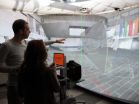Why use a 2-D cursor in a 3-D world? Computer cursors are going 3-D!
University of Montreal researchers present new technology at SIGGRAPH 2015 Conference
2015-08-09
(Press-News.org) This news release is available in Spanish and French.
MONTREAL AND LOS ANGELES, AUGUST 9, 2015 - Researchers at the University of Montreal have developed techniques that enable computer cursors to interact in 3D in single or multiuser, local or remote collaboration scenarios. The system, unveiled today at the SIGGRAPH 2015 Conference in Los Angeles, is not so much about turning Word into an IMAX experience as offering designers an opportunity to navigate through and modify their creations manipulating 3D objects with 3D interactions. "Our new technology challenges the notion of what a cursor is and does," explained lead researcher Professor Tomás Dorta, of the university's School of Design. "The cursor becomes a drawing and controlling plane". The techniques we're unveiling today involves using a tablet to control the cursor, but as it does not necessarily rely on external tracking of the user's movements, eventually other devices could be used, such as smart phones or watches."
What does control plane mean? "We use a Butterfly-net analogy to explain how the cursor selects objects in space - the users simply sweep the 3D cursors through," Dorta said. "For the manipulations of objects, the users can use gestures and movements such as pinching and orientation." The cursor is in fact being demonstrated within the researchers' Hyve-3D design system, a full scale immersive 3D environment that enables users to create drawings on hand-held tablets, which can then be manipulated on the tablets to create a 3D design within the space. As the designers are immersed in their work, for example designing a living room, they can test different furniture options according to the scale and even work on the interior detailing. The immersive images are the result of an optical illusion created by a high-resolution projector, a specially designed 5m-diameter spherically concave fabric screen and a dome mirror projecting the image onto the screen. Specialized techniques render the 3D scene onto a spherical projection in real-time
Univalor, the university's technology commercialization unit, is supporting the market launch of the Hyve-3D system and the 3D cursor, via the startup Hybridlab Inc. Several patents are pending. "Beyond its utility for sketching, we believe the 3D cursor has applications in a wide range of fields, such as architectural design, medical imaging and of course computer games. This isn't a gimmicky rebirth of the cursor, it's about rethinking how humans interact with computers as part of the creative process," Dorta said.
INFORMATION:
ELSE PRESS RELEASES FROM THIS DATE:
2015-08-09
TORONTO -- The brains of people with epilepsy appear to react to music differently from the brains of those who do not have the disorder, a finding that could lead to new therapies to prevent seizures, according to research presented at the American Psychological Association's 123rd Annual Convention.
"We believe that music could potentially be used as an intervention to help people with epilepsy," said Christine Charyton, PhD, adjunct assistant professor and visiting assistant professor of neurology at The Ohio State University Wexner Medical Center, who presented the ...
2015-08-09
SEATTLE, WA, AUGUST 9, 2015 - A new statistical method for analyzing next-generation sequencing (NGS) data that helps researchers study the genome of various organisms such as human tumors and could help bring about personalized cancer treatments was presented today at a session of the 2015 Joint Statistical Meetings (JSM 2015) in Seattle.
Yuan Ji, director of the Program for Computational Genomics and Medicine Research Institute at NorthShore University HealthSystem and associate professor of biostatistics at The University of Chicago, described the new technique--called ...
2015-08-09
SEATTLE, WA, AUGUST 9, 2015 - Linking survey data with administrative records will enable the federal government to better gauge the effectiveness of social welfare programs such as food stamps and federal housing assistance, as well as the overall reach of federal antipoverty initiatives, Bruce D. Meyer today told a session audience at the 2015 Joint Statistical Meetings (JSM 2015) in Seattle.
During a presentation titled "Using Linked Survey and Administrative Data to Better Measure Income: Implications for Poverty, Program Effectiveness, and Holes in the Safety Net," ...
2015-08-08
TORONTO -- The practice of sexting may be more common than generally thought among adults. More than eight out of 10 people surveyed online admitted to sexting in the prior year, according to research presented at the American Psychological Association's 123rd Annual Convention.
"Given the possible implications, both positive and negative, for sexual health, it is important to continue investigating the role sexting plays in current romantic and sexual relationships," said Emily Stasko, MS, MPH, of Drexel University, who presented the research.
Stasko and her co-author, ...
2015-08-08
Researchers shed light on why some plants thrive in different environments while others become extinct
Plants with C4 photosynthesis can thrive in a range of ecological conditions
Discovery could be key in helping improve vital food security
A team of international researchers, led by the University of Sheffield, has moved one step closer to discovering how physiological attributes allow some plants to thrive in a variety of conditions - something that could be the key to future food sustainability.
Climate change strongly impacts on biodiversity, putting some ...
2015-08-07
DOWNERS GROVE, Ill, August 7, 2015 -The FDA recently approved two new endoscopic bariatric therapies (EBT) for the treatment of obesity. According to the American Society for Gastrointestinal Endoscopy (ASGE), this development provides important new, minimally invasive tools for combating the obesity epidemic and offers many patients an alternative to surgery.
The ReShape™ Integrated Dual Balloon System (ReShape™ Dual Balloon) was approved by the FDA on July 29. The ORBERA™ Intragastric Balloon was approved by the FDA on August 6. Many new and emerging ...
2015-08-07
Athens, Ga. - Recent research published in the journal Microsystems & Nanoengineering could eventually change the way people living with prosthetics and spinal cord injury lead their lives.
Instead of using neural prosthetic devices--which suffer from immune-system rejection and are believed to fail due to a material and mechanical mismatch--a multi-institutional team, including Lohitash Karumbaiah of the University of Georgia's Regenerative Bioscience Center, has developed a brain-friendly extracellular matrix environment of neuronal cells that contain very little foreign ...
2015-08-07
When the right gene is expressed in the right manner in the right population of stem cells, the developing mouse brain can exhibit primate-like features. In a paper publishing August 7th in the Open Access journal PLOS Biology, researchers at the Max Planck Institute of Molecular Cell Biology and Genetics (MPI-CBG) succeeded in mimicking the sustained expression of the transcription factor Pax6 as seen in the developing human brain, in mouse cortical progenitor cells. This altered the behavior of these cells to one that is akin to that of progenitors in the developing primate ...
2015-08-07
The common baker's yeast (Saccharomyces cerevisiae) is used to make bread, wine and beer, and is the laboratory workhorse for a substantial proportion of research into molecular and cell biology. It was also the first non-bacterial living thing to have its genome sequenced, back in 1996. However, when the sequence of that genome emerged it appeared that the scientists were seeing double - the organism seemed to have two very different versions of many of its genes. How could this have happened?
Researchers from the Centre for Genomic Regulation (CRG) Barcelona, Spain, ...
2015-08-07
Berkeley -- While the eyes may be a window into one's soul, new research led by scientists at the University of California, Berkeley, suggests that the pupils could also reveal whether one is a hunter or hunted.
An analysis of 214 species of land animals shows that a creature's ecological niche is a strong predictor of pupil shape. Species with pupils that are vertical slits are more likely to be ambush predators that are active both day and night. In contrast, those with horizontally elongated pupils are extremely likely to be plant-eating prey species with eyes on ...
LAST 30 PRESS RELEASES:
[Press-News.org] Why use a 2-D cursor in a 3-D world? Computer cursors are going 3-D!
University of Montreal researchers present new technology at SIGGRAPH 2015 Conference



